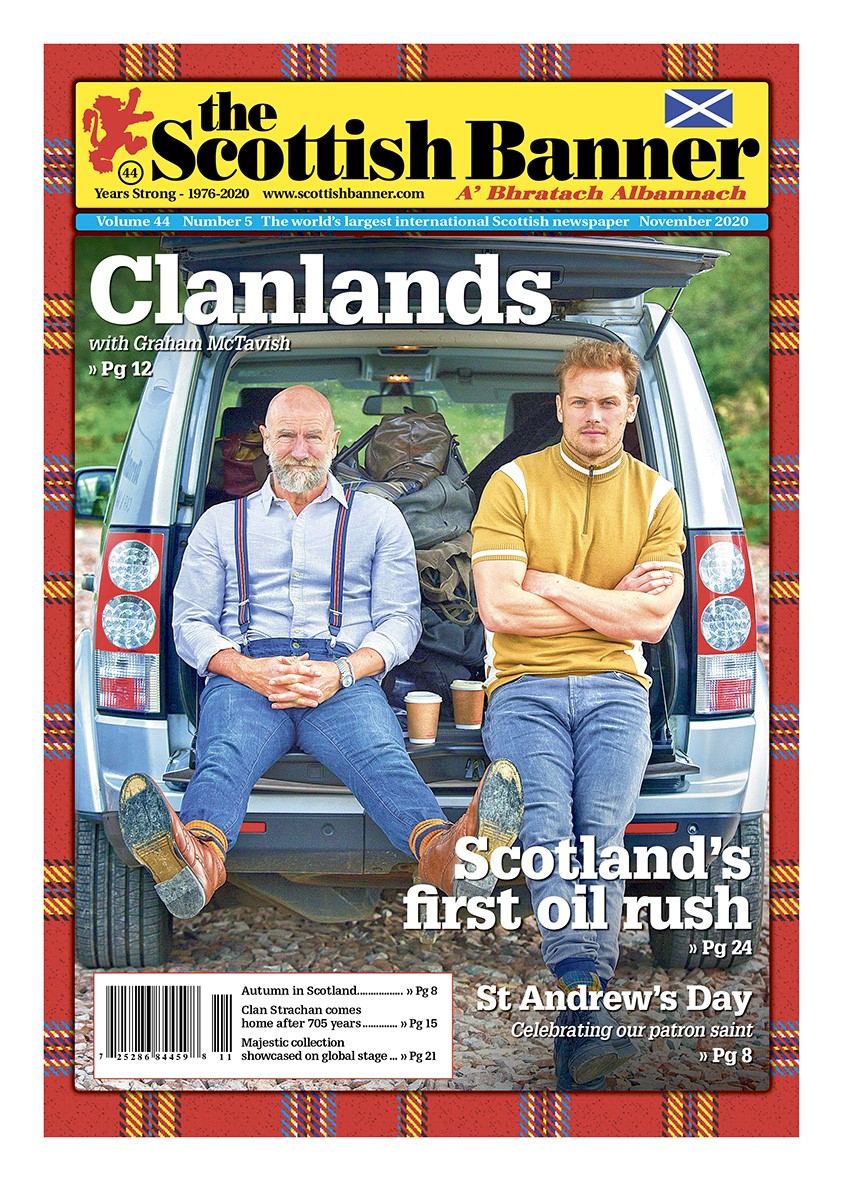November 2020 (Vol. 44, Number 05)
-

Gracing our front cover: Graham McTavish and Sam Heughan, from Men in Kilts and Clanlands. Photo: Starz.
The Banner Says…
Coming full, stone, circle
Over ten thousand years ago the earliest inhabitants of Scotland began erecting stone monuments which have left a shroud of mystery for historians to work out their cultural or spiritual importance.
Folklore and myth surround these large stone formations which can be found across Scotland, with claims of supernatural, sacred, and healing powers. Ancient stones scatter the Scottish landscape today from historic Cairn monuments, stone circles, Neolithic burial chambers and bronze age tombs.
On the Isle of Lewis sits the incredible Calanais Standing Stones. Known in Gaelic as ‘Fir Bhreig’ or ‘false men’, legend has it that they are the petrified souls of the distant past, while scientists now believe these stones were aligned to the sun and the moon.
The Ring of Brodgar in Orkney is Britain’s third largest stone circle. It is believed this was a site of ritual and religious ceremony dating back thousands of years. Others feel it is a shrine to the solstice and changing seasons and even for some a place for UFO’s to land from another universe.
Not far from Inverness and Culloden Moor sits the three circular Clava Cairns. This bronze-age stone built cemetery is believed to have been the burial site of a Pictish king.
Clava Cairns are believed to be up to 4,000 years old and is one of the oldest well-preserved burial sites in Scotland.
In this issue
Speaking of stones, it was in Diana Gabaldon’s Outlander book and TV series, that led character Claire to visit a prehistoric stone circle near Inverness, and fall through the
stones—and into the 18th century and so began an incredible journey not only for Claire but the Outlander franchise. We are delighted to have Graham McTavish, or as some may know as Dougal MacKenzie from the first two series of the show, speak to us about his new book Clanlands and soon to be released TV series Men in Kilts with Outlander’s Sam Heughan. Both Graham and Sam have a true love of Scotland and its incredible story and I can think of few others that can engage so many and keep Scotland on the mind of not just Scots but a worldwide audience.
The rural countryside of West Lothian was changed forever when the shale oil industry took hold from the late 1800s. Communities developed in the shadow of the oil works and began to thrive and still today have a story to tell. A new Shale Trail will educate visitors on Scotland’s oil shale story and create an opportunity for both locals and visitors to learn about Scotland’s shale heritage.
DNA science has been huge for those looking to find their ancestry. Researchers at the University of Strathclyde are now working on discovering the ancient MacDougall bloodline and looking for male MacDougall’s, or with names derived from MacDougall such as Dougal, Dougald, Dougall, MacDougald, MacDougall, McCoull, McDougal, McDougall and McDugle. Participants may just discover what their MacDougall medieval origins are.
The ritual of stones
You can often hear the saying ‘If these walls could talk’, well in Scotland you can also add stones to that phrase. Thousands of years of mythical stories and tales have been created and in many instances their existence still remains a mystery today. Perhaps it is the legends of these great stone monuments that is all we need to keep us fascinated. Folklore and legend have left a physical memorial in Scotland’s many stone spaces and leaves us with many questions of their importance.
Scotland’s connection with stones however does not always have to be with large relics. What got my mind on stones was the recent passing of an incredible lady I knew for nearly
my whole life. Agnes Maxwell was brought up in a Govan tenement by the banks of the River Clyde in Glasgow. Later Agnes would settle in Canada and raise four incredible
daughters, who I grew up with. Agnes believed in the ancient Scottish ritual of stones in relation to loss and grief.
Stones can stand for pain you wish to relinquish, by releasing a stone you release the pain and begin the process of healing. Stones are also a symbol of hope and you can place a
stone in a special place in your home as a promise for the future.
I will now have a special stone at my house for an incredible Scottish lady who touched many, including me, thanks Aggie for all that you were!
Happy St Andrew’s Day
This year celebrations for just about everything are not how we once knew, and that will include St Andrew’s Day on November 30th. St Andrew was officially named the patron saint of Scotland in 1320 and traditional St Andrew’s Day functions take place across the globe (with the exception I hope of only 2020) with a celebration of Scottish food, music, and friendship.
Regardless of how you end up celebrating this year, I hope you find some way to enjoy it.
Have you visited any of Scotland’s ancient stone sites? Do you have you any comments from the content in this month’s edition? Share your story with us by email, post, social media or at: www.scottishbanner.com/contact-us
#ScottishBanner, #TheBanner
Covid-19 is having a major impact on many of our regular advertisers, with events being cancelled and businesses suffering. The Scottish Banner is more reliant than ever on our readers helping us to provide you with our unique content by buying a copy of our publication, regardless if by print or digital subscription or at a retail outlet.
We appreciate your support and hope you enjoy this edition.
